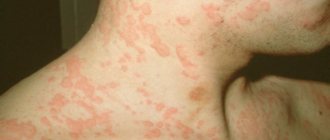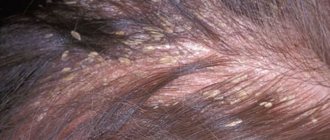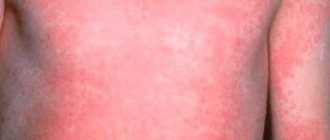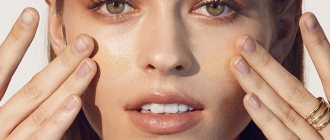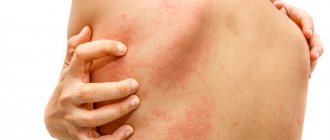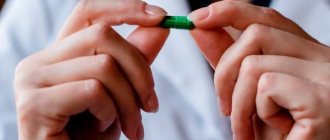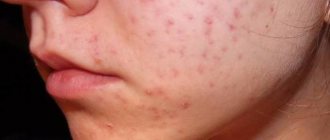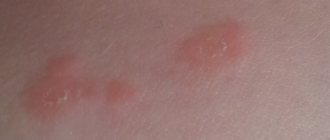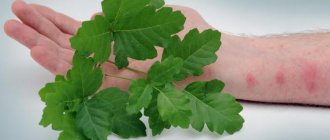Causes – what causes redness and flaking of the skin on the chest and under the breasts
There may be several reasons for the occurrence of these symptoms - for example, peeling of the skin under the breasts can be caused by insufficient hydration or the use of poor quality cosmetics.
Redness may appear due to excessive sweating. In any case, don't despair right away, experts say. First of all, you need to exclude the most obvious and safe diagnoses.
Allergic reactions
Redness of the skin on the chest and rashes are the most undesirable manifestations of an allergic reaction due to the spontaneity of their appearance.
Behavior is almost impossible to predict, but doctors have identified the dependence of the occurrence of symptoms on environmental factors:
- Skin allergies above or below the breasts may appear after a disruption in the functioning of internal organs;
- Also, redness and peeling may appear during pregnancy, even if the woman has not previously suffered from this kind of reaction;
- Peeling of the skin under the breasts can be caused by either a heavily polluted environment or an overly sterile environment.
Genetic predisposition plays a big role: if reactions of this kind have previously been noticed in the family, then with a high degree of probability, redness of the skin on the chest will soon appear.
There may be several allergens that affected the occurrence of reactions, including:
- food products (especially the group of citrus fruits, nuts, honey, milk, etc.);
- pollen of various plants;
- some medications (most often antibiotics);
- chemicals (cosmetics, household chemicals).
However, insect bites and strong emotional outbursts also greatly affect the appearance of rashes and peeling.
Allergic reactions are treated in two ways - hormonal and antihistamine drugs.
Pregnancy
During pregnancy, a woman's body undergoes a complete hormonal change.
Breasts behave differently depending on the trimesters, and experts say that peeling of the skin on the breasts is normal. This reaction can be provoked by the release of a special secretion from the nipples.
However, prolonged pain, accompanied by peeling and redness of the skin, indicates that something is going wrong.
The most common and relatively safe disease with such symptoms is mastitis , inflammation of the mammary gland as a result of stagnation of colostrum in the ducts.
Also characteristic is an increase in body temperature and an enlargement of one of the breasts. As a rule, a course of antibiotics selected by a gynecologist helps a young mother get rid of the problem.
Hormones
For many women, changes in the breasts before menstruation are not something strange.
But for some of them, menstruation turns into a hellish time, and not at all because of stomach pain or mood swings. It's all about "period allergies."
Menstrual dermatosis (or antiprogesterone dermatitis (APD)) is a skin disease associated with menstrual irregularities.
Menstrual dermatosis manifests itself as follows:
- Redness that develops into blisters on the skin of the chest, cheeks and other parts of the body;
- Rash with hemorrhages;
- A rare symptom is itching, but it is most often not intense.
This kind of sensation can occur on the eve of menstruation or before the expected day of ovulation.
This reaction of the body is associated with increased sensitivity to the hormone progesterone - the “pregnancy hormone”.
It is produced during the preparation of the egg for fertilization and during the first 4 months of pregnancy until the placenta is formed.
If pregnancy does not occur, the corpus luteum (the same gland that is involved in the production of progesterone after ovulation) dies and menstruation occurs. Therefore, the symptoms of “allergy” go away with the onset of menstruation.
Also an important role is played by the imbalance of the hormones estrogen, gestagens and androgens due to the influence of various factors - mental and physical stress, emotional stress, etc.
Treatment of APD with antihistamines, as a rule, does not have the desired effect, so the main method is to use drugs that will reduce or “switch off” the menstrual cycle for a while.
If hormonal therapy does not bring positive results, then surgical removal of the ovaries is prescribed.
Diseases and infections
Experts distinguish several breast diseases that are characterized by similar symptoms.
Briefly about each of them:
- Contact dermatitis. The appearance of the disease is influenced by: exposure to chemicals, diseases and parasites, burns, physical friction, allergies. Dermatitis on the chest manifests itself through thickening and redness of the skin, as well as through the appearance of a rash. May be accompanied by peeling of the skin, the formation of necrosis and scabs. When treating, the cause and other diseases are first eliminated. Therapy consists of dietary modification, a combination of anti-inflammatory drugs and corticosteroids;
- Eczema. A common skin lesion is purulent rashes, which are accompanied by redness of the skin of the chest, peeling, itching and the appearance of ulcers. It occurs as a reaction to stress and emotional fatigue, metabolic disorders, various injuries and infections, constant contact of the skin on the chest and under it with wool and synthetic products. Treatment includes the use of sedatives and antibacterial agents, as well as immunocorrectors and antihistamines;
- Candidiasis. A common fungal infection also affects women's breasts, especially during breastfeeding. The disease occurs as a result of a woman’s inability to properly monitor the hygiene of the feeding process. Diagnosis of breast thrush most often occurs when an infection develops in the baby's mouth. The treatment is complex - the doctor selects the necessary antifungal drugs for mother and baby;
- Cyst. A benign lump in the breast, which is accompanied by redness of the skin, increased body temperature and discharge from the nipple in some cases. It is treated by pumping out fluid using a puncture or physiotherapeutic methods;
- Breast cancer. Determined as a result of many tests and studies, it is mainly accompanied by peeling of the skin of the breast and discharge from the nipples. Therefore, if redness or another symptom appears, you should immediately consult a doctor to avoid the degeneration of one disease into another.
Other reasons
This group includes incorrect selection of cosmetics and mechanical friction from wearing the wrong underwear.
In the first case, a consultation with a dermatologist is necessary to understand what exactly the body reacted to, and in the second, changing underwear to a larger size. It is also advisable to wear things made from natural materials.
Symptoms
Spots on the chest are a vague and generalized symptom that can have different variations. So, in some cases, rashes appear that become red, pink or even burgundy. Redness, hyperemia (filling of certain parts of the body with blood and an associated local increase in temperature), and swelling may be observed. Sometimes such symptoms are accompanied by itching, discomfort or burning. It is also possible that the condition of the skin will change, for example, peeling and excessive dryness, keratinization and hardening, and the formation of crusts.
The location and extent of the lesion may also vary. In some cases, single small areas of redness occur, sometimes the spots are numerous, and sometimes the lesions are significant in size and merge, which is why it may seem that almost the entire breast is red.
If you see a spot on your chest, or even more so several spots, then this almost certainly indicates that there is something wrong in the body, and not necessarily in the mammary glands.
Diagnostics
To accurately determine the causes of peeling and redness on the skin of the chest, the following diagnostic studies are performed:
- Study of bacterial flora for the presence of fungus;
- Studying the composition of urine and blood for the presence of inflammatory processes;
- Studying the composition of the blood for sugar levels (to exclude diabetes mellitus as one of the causes of symptoms);
- Ultrasound of the endocrine gland to exclude the influence of endocrine diseases on the appearance of symptoms;
- Ultrasound of the breast to identify tumors;
- Mammography;
- Nipple swabs – only if there is nipple discharge;
- Aspiration biopsy - examination of fluid from a neoplasm to understand exactly what process is developing in the breast;
- Breast MRI.
What to do
The problem should be dealt with by a qualified doctor. Taking antibiotics helps stop inflammation. Additional immunostimulants and sedatives are prescribed. In some cases, it is recommended to steam and massage the breasts. Hormonal correction also helps get rid of spots. Treatment with drugs is carried out under the supervision of physicians.
If stains and irritation are due to improperly fitted underwear, you should change your bra. The product is selected according to its size. The bra should support the bust and not tighten it.
It is important to remember that redness may be due to heat rash. The glands should be washed with warm water daily. Taking a shower will help wash away accumulated sweat and prevent the proliferation of bacterial flora. Water procedures must be carried out without the use of soap, which can irritate the delicate nipple and cause allergies. You need to take care of your mammary glands every day.
Methods for treating skin on the chest
Redness of the skin on the chest is treated in different ways depending on the disease.
Popular methods are creams and ointments for redness and peeling, vitamin complexes and all kinds of folk remedies, under the influence of which the skin returns to its original state.
Ointments and creams for skin
The most commonly used drugs are:
- "Sinalar-N" . The average cost is from 120 rubles. Available in ointment form. The product is applied 2-3 times a day to the damaged area;
- "Lorinden" . The average cost is from 340 rubles. Available in ointment form. At the beginning of treatment, the product is applied up to 3 times a day, after the positive effect appears - up to 2 times. Use for 2 weeks if necessary. It is permissible to use no more than 2 g of product per day;
- "Linin" . The average cost is from 60 rubles. Available in ointment form. The product is applied in a thin layer to damaged areas of the skin 1-2 times a day;
- "Fukortsin" (or Castellani solution). The average cost is from 25 rubles. Available in powder or ready-made liquid form. Lotions with this solution produce a disinfecting effect.
Types of disease
Many pregnant women experience redness in the chest and abdomen. The rash may itch and in some cases cause pain. The main reason for the appearance is stretching of the skin caused by an increase in the amount of estrogen in a woman’s body. In these cases, doctors usually prescribe special ointments and creams that can relieve symptoms.
Eczema is also a common phenomenon during pregnancy. Red spots are localized in the chest area, under it and on the stomach. The rashes itch and after some time, in the absence of proper treatment, become covered with a crust.
Eczema can cause great discomfort if it is of the weeping type - the spots turn into blisters. You can alleviate the condition by taking a warm bath with a decoction of medicinal herbs. Shampoos and shower gels should be replaced with hypoallergenic products.
Angioma is a benign neoplasm that arises from lymphatic and blood capillaries and resembles red moles. Their favorite locations are the hips, stomach and chest. Angioma does not pose any danger. Types of neoplasm:
- branched. It is a system of dilated capillaries. They are several millimeters higher than the level of the skin; when pressed, they change color from red to white;
- consisting of capillaries. Usually located on the stomach and has a small diameter. Color – burgundy-blue;
- tricky. It is a cavity filled with blood cells. Has a bluish tint.
Dermatosis of a polymorphic nature also accompanies a woman during pregnancy. Redness is usually localized on the abdomen and chest and is the result of severe stretching of the skin. They appear in the third semester and are tubercles that spontaneously disappear by the time the child is born. Symptoms of dermatosis can be eliminated with the help of special medications and creams.
Important! All pharmaceutical drugs are prescribed strictly by a specialist if the benefit to the mother outweighs the risk of harm to the fetus.
Rubella is common in pregnant women and can be recognized by the following signs:
- enlarged lymph nodes in the neck;
- increased body temperature;
- fear of light;
- sleep disturbance;
- headache.
The skin then becomes covered with small red ovals. If treatment is not started in time, they merge into a system of large spots. After a few days the problem goes away on its own.
Rubella is a very dangerous disease for the fetus. If the disease occurs in the first trimester, then there is a high probability of termination of pregnancy. In cases where it persists, children are often born with pathologies. Before planning a pregnancy, you should be vaccinated against rubella.
Vitamin deficiency, especially in autumn and spring, can cause redness in the chest and abdomen.
Only a specialist can determine the cause of red spots by conducting diagnostic tests. They usually include examination of the skin, general and biochemical analysis of biological fluids.
Vitamin complexes for healthy skin
Peeling of the skin under the breasts and not only is provoked as a result of a lack of vitamin B groups, which regulate metabolic processes in the body.
Therefore, doctors, when prescribing multivitamin courses, make their choice in favor of those that contain this particular group of vitamins:
- "Revalid". The average cost is from 300 rubles. The most effective drug for the treatment of skin diseases, in addition to B vitamins, contains some minerals and amino acids. In the treatment regimen, drink 2 capsules 3 times a day. In case of prevention, it is enough to take up to 2 capsules per day;
- "Vitasharm". The average cost is from 150 rubles. Vitamins A, group B and PP, which are part of the complex, have a quick healing effect on the skin. It is enough to take 1 tablet per day for a month;
- "Revivona". The average cost is from 320 rubles. The complex is similar to the previous one, but with an expanded list of vitamins. Provides continuous nutrition to skin and hair. Take 1 tablet 3 times a day for children and up to 2 times a day for adults. Your urine may turn bright yellow, but this is completely normal.
Reasons for development
The disease is a complex of symptoms, including:
- swelling;
- itchy sensations;
- rashes on the skin;
- sneezing.
Usually the causes of allergies are increased sensitivity of the immune system and malfunctions of the body. The first case represents true allergic reactions, the second – pseudo-allergy.
The immune system is responsible for the development of allergic processes. The purpose of its work is to protect the body from penetration of harmful objects. The immune system reacts sharply when the limits of its permissible self-defense are exceeded, and its own tissues are damaged. The body's aggressive response is an allergy.
Factors provoking the development of pathology:
- pollen;
- waste products of microorganisms found in dust;
- food (common allergens are nuts and fruits);
- animal hair;
- medicines;
- perfumes and household chemicals;
- heredity;
- ecology;
- chemical additives in food;
- exceeding hygiene procedures. If hygiene is too intense, the body’s protective functions are weakened, and in order to overload itself, it looks for an enemy in all the household items and life activities surrounding a person.
Another factor that is worth highlighting separately is pregnancy. During pregnancy, a woman's immune system works differently. Allergic reactions can occur even if the girl has not been exposed to them before. This is explained by the fact that the content of progesterone in the body increases, and all processes become aggravated.
Important! At the first signs of allergic reactions, it is necessary to contact a specialist as soon as possible to identify the factor that developed the pathology. Severely advanced allergies can be life-threatening!
Causes of spots and additional signs: table of symptoms
If you find yourself with a spot, check the symptom chart. Some spots are not dangerous and do not even need to be treated. Others are a beacon of serious illness. A spot in the bust area may appear:
- due to allergies (food, care products, synthetic underwear);
- traumatic injury;
- insect bite;
- disruption of the gastrointestinal tract;
- as a result of dyschromia (pigmentation disorders due to stress, metabolic disorders, ovarian dysfunction), for example, vitiligo;
- parasitic diseases;
- fungal infections.
| Spot color | Description of the spots | Additional signs | Possible cause of the problem |
| Red or pink | Purple spots between the breasts (breasts) | Scratches and pain | Tissue damage from bra underwire |
| Urticular (like tubercles) scarlet under the breasts, on the chest, back, neck | Severe itching, rapid increase in area of rashes | Urticaria (food allergy) | |
| Spots in the bust area, small in size, sometimes looking like small bumps or blisters | Sometimes itchy. Sometimes spots appear asymptomatically or due to insomnia | Excessive excitement. Stress Changes in temperature and humidity conditions | |
| Crimson small formations | Itching | Contact dermatitis | |
| Small spots on the bust and abdomen | Mild itching | Miliaria (appears in summer). Drug allergy. | |
| Spots on the bust, neck and abdomen | Itching, pimples, peeling | Eczema developed due to damage to the gastrointestinal tract, due to genetic predisposition or weak immunity | |
| Education in the field of mammary glands | Increase in local temperature, compaction | Lactostasis | |
| Single scarlet spots similar to herpetic formations | Itching, weeping, small bleeding sores, skin erosion and changes in the shape of the nipple | Paget's cancer | |
| Spots in the mammary glands | Hyperemia of the skin of the bust (redness), increased local temperature, thickening of the skin, swelling and pain | Erysipelas-like cancer, characterized by vascular reaction and rapid proliferation of atypical cells | |
| Protruding formation on the skin, congenital or acquired | No | Mole | |
| Minor rashes | Papules, weeping, itching, scabs (crusts) | Herpes | |
| Extensive lesions on the chest and under the breasts | Redness, itching, peeling | Fungus | |
| Redness in the breast area | Increase in local and general temperature, compaction | Mastitis | |
| Brown | Congenital formation, can be of any shape (usually round) from light brown to black | No | Birthmark (mole) |
| A growth that rises above the surface of the skin, pigmented tissue that is spongy | No | Wart | |
| Light brown formations on the skin are initially isolated, then spreading over the entire surface of the bust and abdomen | The spots are slightly flaky and itchy. | Versicolor/pityriasis versicolor | |
| Light-brown (less often scarlet-reddish) areas on the skin of the gland with a diameter of 10 mm, over time merging into one pigmented area the size of a palm | Reduction in the size of the affected gland, hardening and thickening of the skin | Armored cancer | |
| From light to dark brown spots of different sizes | Flat or slightly raised above the surface | Pigment spots. Age-related hyperkeratosis | |
| Blue | The formation looks like a hematoma, single | The compaction is palpable | Nodular form of cancer |
| Formation of blue, greenish, yellowish color | Pain, swelling. During the healing stage, the breasts are slightly itchy | Hematoma | |
| White | Spots of different sizes | White strand (piebaldism). Spots on the face, abdomen (vetiligo) | Leucoderma (piebaldism, vitiligo) |
| Depends on the cause of pigmentation changes | Consequences of psoriasis, favus, eczema, lichen | ||
| Consequences of stress or inflammation. Pigment cells (melanocytes) die due to acute vascular spasm | |||
| Black | Formations of different sizes, flat or raised above the surface of the skin | Sometimes hair grows from the formation | Melanocytic nevus (mole) |
| Formations of different sizes | Spots during pregnancy on the neck and chest of women | Chloasma (melasma) or melasma | |
| Hyperpigmentation (dark, almost black, coloration of the skin) | Symmetrical hyperpigmentation of the neck, feet, intergluteal fold, in the groin, around the lips and armpits, papillomatosis (extensive growth of papillomas), hyperkeratosis (thickening of the skin). | Acanthosis nigricans (negroid) |
